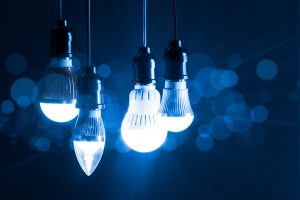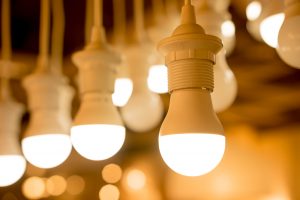LED Light Bulbs: Are they as Efficient as they Say?

When it comes to lighting – and especially when it comes to lighting our homes – there is a whole load of new technologies on the market. People claim they are more efficient and will save us money on our electricity bills. One example is LED light bulbs.
LED light bulbs were created as an alternative to incandescent and energy saving bulbs.
But, are they really as good as they say? Do they really save us as much on our electricity bills as people claim?
Some people are still a little reluctant to swop the ordinary light bulbs they use in their homes for LED light bulbs because they don’t believe these claims.
In today’s article, we’ll tell you all about LED light bulbs, and reveal if everything people say is true.
What are LED light bulbs?
If we’re going to talk about LED light bulbs, the first thing you need to know is what they are. So, what exactly is an LED light bulb?
An LED light bulb is defined as a solid-state lighting device that uses light-emitting diodes to produce light.
They are the most efficient of all light bulbs, as they have a lifespan of up to 50,000 hours (around 30 years). They are able to withstand being turned on and off constantly. Plus, they consume approximately 80% less energy than incandescent light bulbs.
This type of bulb can be used anywhere, not just domestically, but also commercially, for example in hotels.
They aren’t the only light bulbs on the market, but they are the most innovative, thanks to their long lifespan and high efficiency.
However, to understand the advantages of LED light bulbs, you need to know about the other bulbs on the market today.

Types of light bulb
- Incandescent light bulbs: the traditional light bulb. Over the last decade, countries around the world have been gradually phasing them out, due to their low energy efficiency.
- Energy-saving light bulbs: after LED light bulbs, these are the most energy efficient. The downside is that they’re not recommended for high-traffic areas of your homes, such as bathrooms or hallways. This is because turning them on and off frequently can considerably reduce their lifespan. Plus, switching them on can take a couple of seconds.
- Eco halogen bulbs: this type of bulb produces a very natural looking light, and it will turn on almost instantly. They consume 30% less energy than incandescent bulbs.

Are they as efficient as people say?
If you’re someone who doesn’t have much faith in LED light bulbs, we hate to break it to you, but everything people say about them is true. Here’s why.
Firstly, LED light bulbs need less power to produce the same amount of light as traditional bulbs. This means that they’ll consume fewer kW/h and they’ll end up costing you less. So, they are more cost-efficient.
The following table should help to illustrate exactly what we’re talking about:
| LED | Incandescent | |
| Power (W) | 7 | 60 |
| Hours of use per day | 7 | 7 |
| No. of bulbs | 10 | 10 |
| Energy used per day (kW) | 0.49 | 4.2 |
| Energy used per month (kWh) | 15.19 | 130.2 |
| Price/kW | 0.118 | 0.118 |
| Monthly cost | 1.79 | 15.37 |
As you can see, the difference in monthly cost is huge, saving around 88%.
Low energy light bulbs are also a good way to save money. They aren’t as efficient as LED bulbs, but in comparison to other types, they can help to save you around 75-80%. However, they do have a shorter lifespan.
As well as lowering your monthly spend, the cost of an LED light bulb is around 4-8 euros, so you’ll save money in the long run.
This means that you’ll soon get back the initial investment you make in buying your bulbs.
However, if you still use low energy bulbs, just wait until their lifespan comes to an end. If, on the other hand, you have halogen or incandescent bulbs, you should consider changing them now, at least in the rooms you use most.

Conclusion
Lighting our homes is a very important issue. You need to give it some thought if you want to light your home efficiently.
LED light bulbs are a type of light bulb that you can use to save money on your electricity bill, without having to compromise on the quality of your lighting. Quite the opposite in fact, because, as we have seen, these bulbs can produce the same amount of light using less energy than traditional light bulbs.
Plus, they are safer than other bulbs, as they don’t produce any heat.
Their price shouldn’t be a problem either. Although they are slightly more expensive than other types of light bulb, thanks to their energy efficiency and their long lifespan, you’ll save money in the long term.
When it comes to lighting – and especially when it comes to lighting our homes – there is a whole load of new technologies on the market. People claim they are more efficient and will save us money on our electricity bills. One example is LED light bulbs.
LED light bulbs were created as an alternative to incandescent and energy saving bulbs.
But, are they really as good as they say? Do they really save us as much on our electricity bills as people claim?
Some people are still a little reluctant to swop the ordinary light bulbs they use in their homes for LED light bulbs because they don’t believe these claims.
In today’s article, we’ll tell you all about LED light bulbs, and reveal if everything people say is true.
What are LED light bulbs?
If we’re going to talk about LED light bulbs, the first thing you need to know is what they are. So, what exactly is an LED light bulb?
An LED light bulb is defined as a solid-state lighting device that uses light-emitting diodes to produce light.
They are the most efficient of all light bulbs, as they have a lifespan of up to 50,000 hours (around 30 years). They are able to withstand being turned on and off constantly. Plus, they consume approximately 80% less energy than incandescent light bulbs.
This type of bulb can be used anywhere, not just domestically, but also commercially, for example in hotels.
They aren’t the only light bulbs on the market, but they are the most innovative, thanks to their long lifespan and high efficiency.
However, to understand the advantages of LED light bulbs, you need to know about the other bulbs on the market today.

Types of light bulb
- Incandescent light bulbs: the traditional light bulb. Over the last decade, countries around the world have been gradually phasing them out, due to their low energy efficiency.
- Energy-saving light bulbs: after LED light bulbs, these are the most energy efficient. The downside is that they’re not recommended for high-traffic areas of your homes, such as bathrooms or hallways. This is because turning them on and off frequently can considerably reduce their lifespan. Plus, switching them on can take a couple of seconds.
- Eco halogen bulbs: this type of bulb produces a very natural looking light, and it will turn on almost instantly. They consume 30% less energy than incandescent bulbs.

Are they as efficient as people say?
If you’re someone who doesn’t have much faith in LED light bulbs, we hate to break it to you, but everything people say about them is true. Here’s why.
Firstly, LED light bulbs need less power to produce the same amount of light as traditional bulbs. This means that they’ll consume fewer kW/h and they’ll end up costing you less. So, they are more cost-efficient.
The following table should help to illustrate exactly what we’re talking about:
| LED | Incandescent | |
| Power (W) | 7 | 60 |
| Hours of use per day | 7 | 7 |
| No. of bulbs | 10 | 10 |
| Energy used per day (kW) | 0.49 | 4.2 |
| Energy used per month (kWh) | 15.19 | 130.2 |
| Price/kW | 0.118 | 0.118 |
| Monthly cost | 1.79 | 15.37 |
As you can see, the difference in monthly cost is huge, saving around 88%.
Low energy light bulbs are also a good way to save money. They aren’t as efficient as LED bulbs, but in comparison to other types, they can help to save you around 75-80%. However, they do have a shorter lifespan.
As well as lowering your monthly spend, the cost of an LED light bulb is around 4-8 euros, so you’ll save money in the long run.
This means that you’ll soon get back the initial investment you make in buying your bulbs.
However, if you still use low energy bulbs, just wait until their lifespan comes to an end. If, on the other hand, you have halogen or incandescent bulbs, you should consider changing them now, at least in the rooms you use most.

Conclusion
Lighting our homes is a very important issue. You need to give it some thought if you want to light your home efficiently.
LED light bulbs are a type of light bulb that you can use to save money on your electricity bill, without having to compromise on the quality of your lighting. Quite the opposite in fact, because, as we have seen, these bulbs can produce the same amount of light using less energy than traditional light bulbs.
Plus, they are safer than other bulbs, as they don’t produce any heat.
Their price shouldn’t be a problem either. Although they are slightly more expensive than other types of light bulb, thanks to their energy efficiency and their long lifespan, you’ll save money in the long term.







